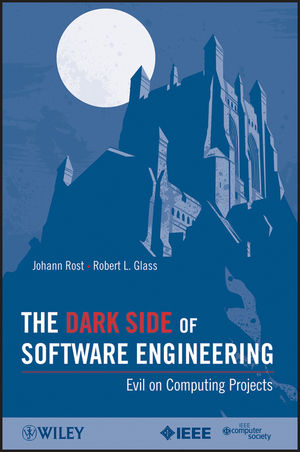The Dark Side of Software Engineering: Evil on Computing ProjectsISBN: 978-0-470-59717-0
Paperback
316 pages
February 2011, Wiley-IEEE Computer Society Press
 This is a Print-on-Demand title. It will be printed specifically to fill your order. Please allow an additional 10-15 days delivery time. The book is not returnable.
|
||||||
INTRODUCTION.
I.1 What's the Dark Side?
I.1.1 Why the Dark Side?
I.1.2 Who Cares About the Dark Side?
I.1.3 How Dark is the Dark Side?
I.1.4 What Else is on the Dark Side?
I.1.5 Ethics and the Dark Side.
I.1.6 Personal Anecdotes About the Dark Side.
Reference.
PART 1: DARK SIDE ISSUES.
CHAPTER 1 SUBVERSION.
1.1 Introductory Case Studies and Anecdotes.
1.1.1 A Faculty Feedback System.
1.1.2 An Unusual Cooperative Effort.
1.1.3 Lack of Cooperation due to Self Interest.
1.1.4 An Evil Teammate.
1.1.5 Thwarting the Evil Union.
1.2 The Survey: Impact of Subversive Stakeholders On Software Projects.
1.2.1 Introduction.
1.2.2 The Survey.
1.2.3 The Survey Findings.
1.2.4 Conclusions.
1.2.5 Impact on Practice.
1.2.6 Impact on Research.
1.2.7 Limitations.
1.2.8 Challenges.
1.2.9 Acknowledgments.
1.3 Selected Responses.
1.3.1 Sample Answers to the Question: "What Were the Motivations and Goals of the Subversive Stakeholders?"
1.3.2 Sample Answers to the Question "How Were the Subversive Attacks Discovered?"
1.3.3 Sample Answers to the Question "How Can Projects be Defended Against Subversive Stakeholders?"
1.4 A Follow-Up to the Survey: Some Hypotheses and Related Survey Findings.
References.
CHAPTER 2 LYING.
2.1 Introductory Case Studies and Anecdotes.
2.2 Incidents of Lying: The Survey.
2.2.1 The Survey Results.
2.2.2 General Scope.
2.2.3 An Overview of the Problem.
2.2.4 Clarifi cation of Terms.
2.2.5 Discussion.
2.2.6 Conclusions.
2.2.7 Limitations.
2.3 Qualitative Survey Responses on Lying.
2.4 What Can Be Done About Lying?
2.5 The Questionnaire Used in the Survey.
References.
CHAPTER 3 HACKING.
3.1 Case Studies of Attacks and Biographies of Hackers.
3.2 Cyber Terrorism and Government-Sponsored Hacking.
3.3 The Hacker Subculture.
3.3.1 Why They Are Called "Hackers".
3.3.2 Motivation of Hackers.
3.3.3 Hacker Slang.
3.3.4 Hacker Ethics.
3.3.5 Public Opinion about Hackers.
3.4 How a Hacker Is Identified.
3.5 Time Line of a Typical Malware Attack.
3.6 Hacker Economy: How Does a Hacker Make Money?
3.7 Social Engineering.
3.7.1 Social Engineering Examples and Case Studies.
3.7.2 Tactics of Social Engineering.
3.8 A Lingering Question.
3.9 Late-Breaking News.
CHAPTER 4 THEFT OF INFORMATION.
4.1 Introduction.
4.2 Case Studies.
4.2.1 Data Theft.
4.2.2 Source Code Theft.
4.3 How Do the Victims Find Out That Their Secrets Are Stolen?
4.4 Intellectual Property Protection.
4.4.1 Trade Secret Protection.
4.4.2 Copyright Protection.
4.4.3 Patent Protection.
4.4.4 Steganography.
4.5 Open Versus Closed Source.
CHAPTER 5 ESPIONAGE.
5.1 Introduction.
5.2 What Is Espionage?
5.3 Case Studies.
5.3.1 Sweden Versus Russia.
5.3.2 Shekhar Verma.
5.3.3 Lineage III.
5.3.4 GM versus VW: Jose Ignacio Lopez.
5.3.5 British Midland Tools.
5.3.6 Solid Oak Software.
5.3.7 Proctor & Gamble versus Unilever.
5.3.8 News Corp Versus Vivendi.
5.3.9 Spying: Was A TI Chip Really Stolen by a French Spy?
5.3.10 Confi cker.
5.4 Cyber Warfare.
Reference.
CHAPTER 6 DISGRUNTLED EMPLOYEES AND SABOTAGE.
6.1 Introduction and Background.
6.2 Disgruntled Employee Data Issues.
6.2.1 Data Tampering.
6.2.2 Data Destruction.
6.2.3 Data Made Public.
6.2.4 Theft Via Data.
6.3 Disgruntled Employee Software Issues.
6.3.1 Software Destruction.
6.4 Disgruntled Employee System Issues.
6.5 What to Do About Disgruntled Employee Acts.
6.6 Sabotage.
References.
CHAPTER 7 WHISTLE-BLOWING.
7.1 A Hypothetical Scenario.
7.2 Whistle-Blowing and Software Engineering.
7.3 More Case Studies and Anecdotes.
7.3.1 Jeffrey Wigand and Brown and Williamson Tobacco.
7.3.2 A Longitudinal Study of Whistle-Blowing.
7.3.3 An Even More Pessimistic View.
7.3.4 Academic Whistle-Blowing.
7.3.5 The Sum Total of Whistle-Blowing.
References.
APPENDIX TO CHAPTER 7 PRACTICAL IMPLICATIONS OF THE RESEARCH INTO WHISTLE-BLOWING.
References.
PART 2: VIEWPOINTS ON DARK SIDE ISSUES.
Introduction.
CHAPTER 8 OPINIONS, PREDICTIONS, AND BELIEFS.
8.1 Automated Crime (Donn B. Parker).
Information Sources.
8.2 Let's Play Make Believe (Karl E. Wiegers).
Reference.
8.3 Dark, Light, or Just Another Shade of Grey? (Les Hatton).
8.4 Rational Software Developers as Pathological Code Hackers (Norman Fenton).
CHAPTER 9 PERSONAL ANECDOTES.
9.1 An Offi cer and a Gentleman Confronts the Dark Side (Grady Booch).
9.2 Less Carrot and More Stick (June Verner).
References.
9.3 "Them and Us": Dispatches from the Virtual Software Team Trenches (Valentine Casey).
9.4 What is it to Lie on a Software Project? (Robert N. Britcher).
9.5 "Merciless Control Instrument" and the Mysterious Missing Fax (A. H. (anonymous)).
9.6 Forest of Arden (David Alan Grier).
9.7 Hard-Headed Hardware Hit Man (Will Tracz).
9.8 A Lighthearted Anecdote (Eugene Farmer).
CONCLUSIONS.
INDEX.



